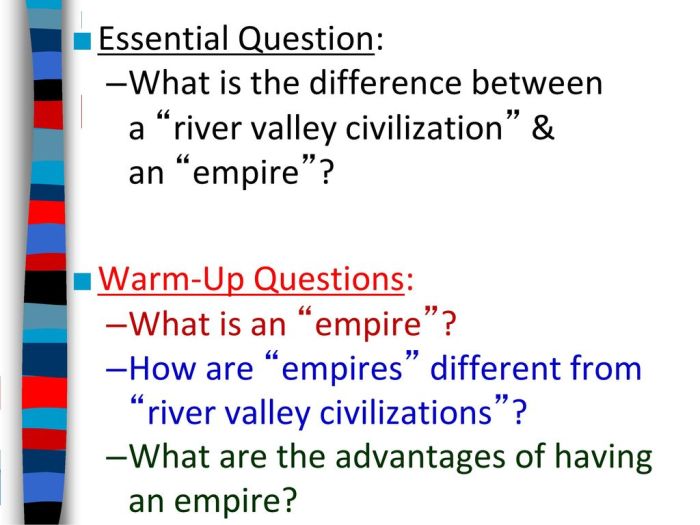How are empires different from river valley civilizations – Embarking on an exploration of the distinct characteristics that set empires apart from river valley civilizations, this comprehensive analysis delves into the historical origins, political structures, economic systems, social dynamics, technological advancements, and eventual decline of these two pivotal societal models.
Unveiling the intricate tapestry of human civilization, this discourse unravels the factors that shaped the rise and fall of empires and river valley civilizations, offering a profound understanding of their profound impact on the course of history.
Defining Empires and River Valley Civilizations

Empires are large-scale political entities characterized by centralized authority, territorial expansion, and a complex administrative system. They often encompass multiple ethnic groups and territories, and their power is typically maintained through a combination of military force and economic control.River valley civilizations, on the other hand, are early societies that developed in the fertile floodplains of major rivers.
They were based on agriculture and irrigation, and their populations were organized into hierarchical social structures. River valley civilizations were typically characterized by monumental architecture, a written language, and a complex system of religious beliefs.
Origins and Development: How Are Empires Different From River Valley Civilizations

The origins of empires can be traced back to the Bronze Age, when the emergence of metalworking and warfare enabled the rise of powerful chiefdoms. These chiefdoms gradually expanded their territories and consolidated their power, eventually forming the first empires.
River valley civilizations, on the other hand, emerged in the Neolithic period, as a result of the transition from hunting and gathering to agriculture. The availability of fertile land and water resources allowed for the growth of settled populations and the development of complex social and political structures.
Political Structures and Governance
Empires typically have a centralized political structure, with a single ruler or emperor at the apex of power. The emperor is responsible for maintaining law and order, collecting taxes, and administering justice. The empire is often divided into provinces or districts, each governed by a local official appointed by the emperor.
River valley civilizations, on the other hand, typically have a more decentralized political structure, with power shared among a ruling elite or council of elders. The rulers are responsible for managing the irrigation system, resolving disputes, and performing religious rituals.
Economic Systems and Trade

Empires have a complex economic system based on agriculture, trade, and manufacturing. They often control vast agricultural lands and employ a variety of labor systems, including slavery, serfdom, and free labor. Trade is an important source of wealth for empires, and they often establish extensive trade networks that span multiple regions.
River valley civilizations, on the other hand, have a more localized economy based on agriculture and local markets. They typically rely on irrigation to cultivate crops, and their trade is limited to nearby regions.
Answers to Common Questions
What are the key differences between empires and river valley civilizations?
Empires typically encompass vast territories with diverse populations, governed by a centralized authority, while river valley civilizations are concentrated in specific geographical regions, relying on agriculture and local resources.
How did empires and river valley civilizations differ in their political structures?
Empires often featured hierarchical political systems with an emperor or monarch at the helm, while river valley civilizations tended to have more decentralized governance with power distributed among elites and local leaders.
What were the main economic activities of empires and river valley civilizations?
Empires engaged in extensive trade and commerce, spanning vast distances, while river valley civilizations primarily focused on agriculture and local markets.
How did empires and river valley civilizations contribute to technological advancements?
Empires fostered innovation in engineering, architecture, and science, while river valley civilizations made significant contributions in agriculture, irrigation, and metallurgy.